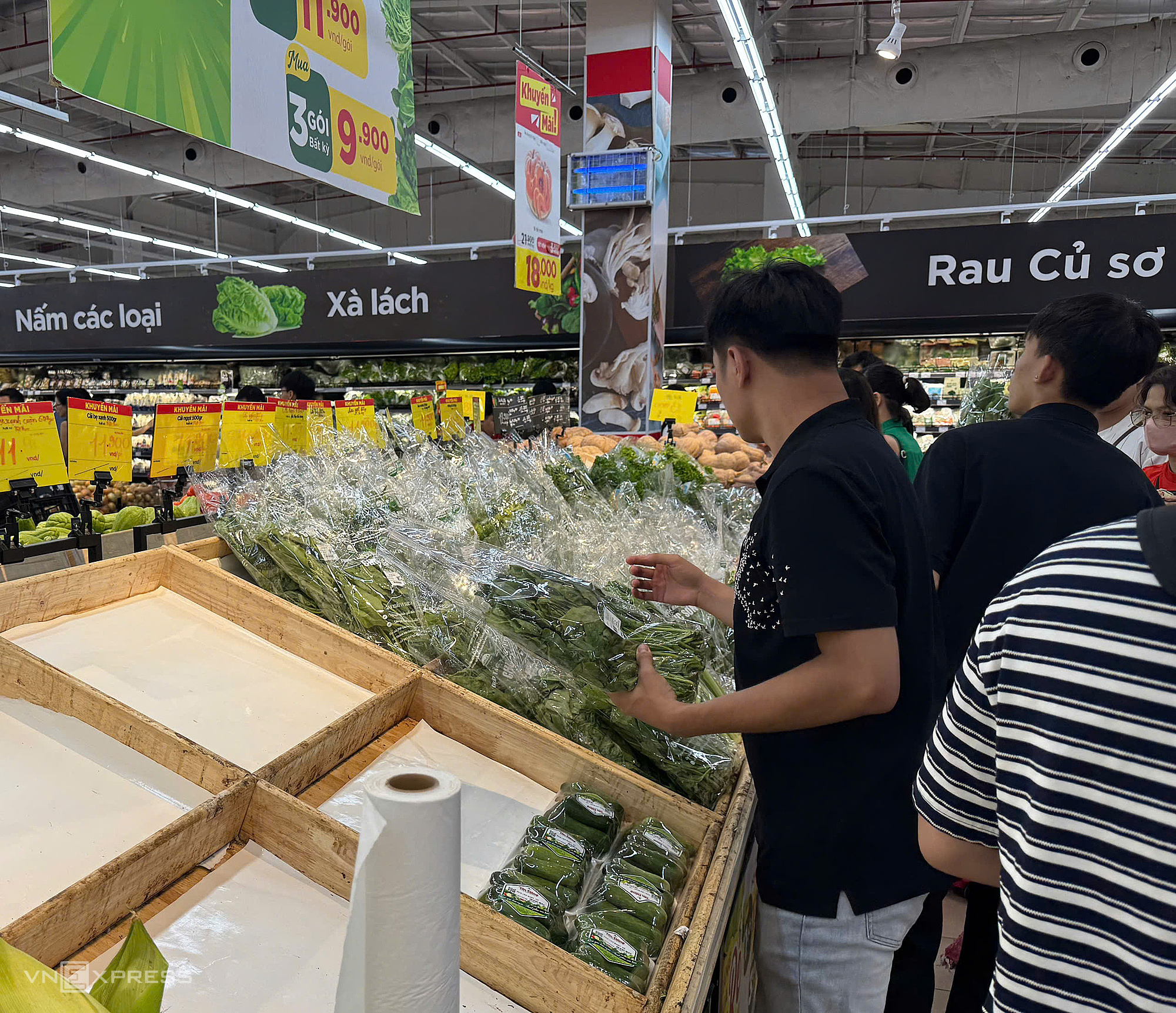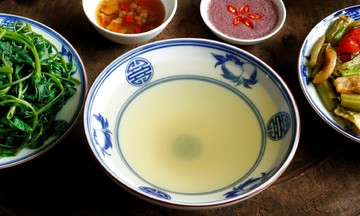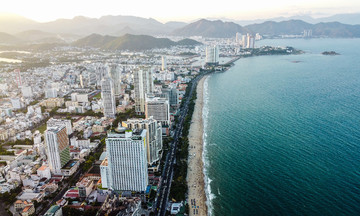The food aisles were packed. At the bakery, Bich had to fight her way through the crowd to grab two loaves of bread.
"The shelves in the produce section were empty. Only less popular instant noodle brands remained," Bich said. Even though she couldn't find many items on her list, she still had to wait in line for almost 30 minutes to check out.
According to Bich, the habit of stockpiling food developed for her family and many neighbors after Typhoon Yagi in 9/2024. The intense storm and its widespread impact left many families isolated, unable to go to the market or order groceries for days.
"Last year, we had to eat instant noodles for three days straight. Learning from that experience, this year we're not buying in bulk, but we are getting enough essential supplies," she said.
Since the morning of 20/7, the family of Hong Hanh, 50, from Gia Vien ward, Hai Phong, has also been busy preparing food and essential supplies in anticipation of Typhoon Wipha's landfall.
Hanh had to visit two large supermarkets to find everything she needed. The first one was out of fresh vegetables, and the second was out of meat and fish. "Shopping for two days' worth of supplies felt like preparing for the end of the world, everyone was stocking up," Hanh said.
Past experiences with power and water outages after storms have led people to prepare more thoroughly. Besides food, Hanh checked her rooftop water tank to ensure it was full in case the water supply was disrupted. She also boiled water and filled thermoses to have hot water for making formula and instant noodles if the power went out.
Bich also fully charged her electronic devices, power banks, and rechargeable lights. On Hai Phong residents' social media groups, videos and photos showing empty shelves in supermarkets were widely shared.
 |
Hanoi residents rush to supermarkets to stock up on food in preparation for the storm, 21/7. Photo: Quynh Nguyen |
A VnExpress survey on 21/7 in Quang Ninh, Hung Yen, Ninh Binh, and Thanh Hoa showed that residents there were also starting to stockpile essential goods. However, instead of flocking to large supermarkets, they preferred shopping at local markets closer to home.
Le Loan, 45, a vegetable vendor in Hung Yen, said that vegetables were the most sought-after items, despite prices being 10-15% higher than usual. Meat, eggs, and dried goods like instant noodles and rice paper also saw a surge in sales. The impending storm prompted decisive purchasing.
"Because of the habit of shopping at local markets and some rural households growing their own vegetables and raising poultry, the rush to supermarkets isn't as overwhelming as in larger cities," Loan said.
Taking advantage of her company's work-from-home policy starting on the afternoon of 21/7, Ngoc Han from Yen Hoa ward, Hanoi, also went to the supermarket to buy food for the next three days.
With her home out of groceries and living far from a traditional market, the 27-year-old office worker made a list of items to buy, including vegetables, meat, eggs, and dried goods. Initially, Han planned to visit the market near her office, but by noon, most stalls were closed, and the few remaining ones sold bruised vegetables at higher prices.
"I thought the supermarket would be less crowded in the afternoon, but I didn't expect so many people, even though it's only Tuesday," Han said.
By 3:30 p.m., the supermarket parking lot was full. Inside, the produce, fresh meat, instant noodles, and canned goods sections were the most crowded. Employees constantly restocked shelves, but the items quickly disappeared.
Like Han, many Hanoi residents shared the same sense of precaution. From midday, some companies had announced that employees would work remotely until the end of 23/7 for safety reasons and to allow them time to prepare.
A security guard at a supermarket on Tran Duy Hung Street, Yen Hoa ward, said that while the number of customers wasn't as high as on weekends, it was significantly higher than on weekdays, especially since early afternoon.
 |
The vegetable section of a large supermarket on Tran Duy Hung Street, Yen Hoa ward, Hanoi, is constantly busy due to high demand, forcing staff to continuously restock, afternoon of 21/7. Photo: Nga Thanh |
As Associate Professor Dr. Bui Thi An, Director of the Institute of Environmental Resources and Community Development, previously shared with VnExpress, Typhoon Yagi demonstrated the effectiveness of Hanoi and other provinces' suppliers in ensuring people's livelihoods.
"Before and after the storm, supermarkets and markets remained open, and goods were plentiful. Therefore, people should prepare necessary items thoroughly but remain calm and avoid excessive worry," An said.
According to the National Center for Hydro-Meteorological Forecasting, at 7 a.m. on 21/7, Typhoon No. 3 (Wipha) was located approximately 220 km east of Quang Ninh - Hai Phong. It packed maximum sustained winds of level 9, with gusts reaching level 11. From the night of 21/7, coastal areas from Quang Ninh to Nghe An were forecast to experience strong winds and heavy rain, with rainfall totals of 200-350 mm, and over 600 mm in some areas, posing a high risk of flooding and landslides.
Nga Thanh - Quynh Nguyen












